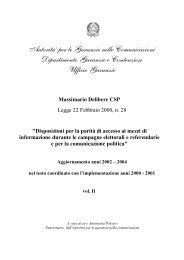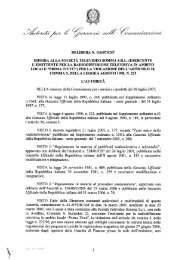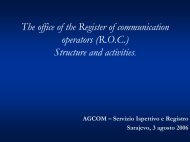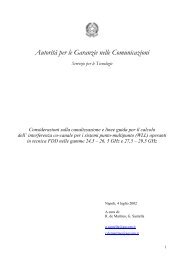Communications Regulatory Authority
Communications Regulatory Authority
Communications Regulatory Authority
You also want an ePaper? Increase the reach of your titles
YUMPU automatically turns print PDFs into web optimized ePapers that Google loves.
But the fixed-mobile convergence is not just limited to integrated operators: it<br />
also concerns, in different forms, operators present in just one of the two<br />
telecommunications markets. The operators that do not hold mobile infrastructure can<br />
offer integrated service packages by acquiring mobile operators or by entering into<br />
collaborative arrangements with them (ranging from partnership agreements to mobile<br />
network leasing contracts, as in the case of virtual mobile operators). On the other hand,<br />
as for the operators operating only in the mobile sector, these can counter the integrated<br />
offerings by acquiring fixed operators or Internet Service Providers (with whom they<br />
can provide broadband activities and, as necessary, Internet Protocol voice services),<br />
launching initiatives aiming to encourage the replacement of fixed with mobile<br />
telephony (proposing, for example, convenient rates for calls to fixed network numbers<br />
made from home), or focusing on the availability of wireless broadband networks as an<br />
alternative to fixed ones (to completely replace the fixed line).<br />
A second route concerns the converging offers of telecommunications services<br />
and audiovisual contents. Last year saw the launching of numerous converging<br />
initiatives ranging from offerings of Internet Protocol TV (IPTV) to mobile television<br />
(in various technological standards, such as DVB-H, MediaFLO, and DMB).<br />
In short, the convergence is adding further services to the by now traditional<br />
voice and broadband Internet access (double play) services provided by fixed network<br />
operators; the integration of telecommunications with the audiovisual sector broadens<br />
the offering of services to include television (triple play), while the fixed-mobile<br />
convergence makes it possible to complete the range, offering consumers a single allinclusive<br />
package of communication services (quadruple play).<br />
The advent of finally converging products and services is thus determining<br />
profound changes in the sector’s competitive scenario. Indeed, during the past year there<br />
has been a significant upswing in merger & acquisition activities.<br />
In the United States, the main operation concerned the merger of AT&T with<br />
BellSouth, which followed the completion of the acquisition of AT&T by SBC in 2005,<br />
and Verizon’s acquisition of MCI.<br />
In Europe, too, there have been numerous events on the corporate structure<br />
change front, among which worthy of mention are:<br />
− the acquisition, in late July 2005, of Amena by France Télécom, through its<br />
Orange mobile division; the Spanish operator Amena will then be merged<br />
with France Télécom España, a company of the French incumbent operator<br />
which offers ADSL connectivity in Spain;<br />
− Telefónica’s purchase of O2 and Cesky Telecom, thanks to which the<br />
Spanish operator is now able to offer fixed-mobile services in the Czech<br />
Republic and Germany;<br />
5















